 |
 |
| |
|
| |
|
|
| |
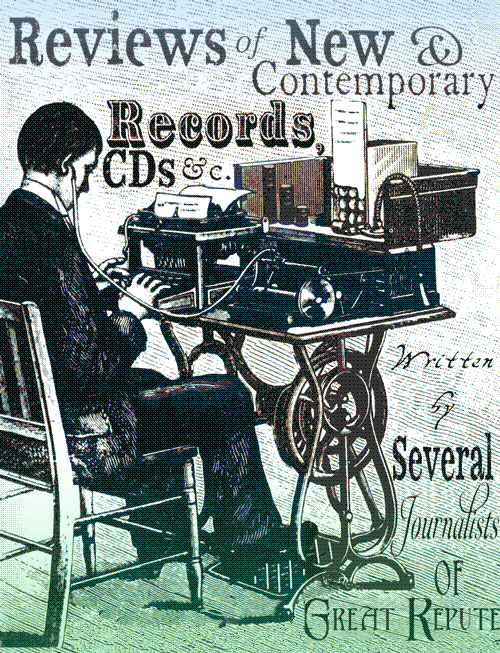 |
|
| = October 2015 = |
|
|
| Mary Lou Lord |
| The Garment District |
| Fur for Fairies |
| In Gowan Ring |
| Number 3 Combo |
| Hey Colossus |
| Get the Blessing |
| Class M Planets |
| Lost Station Tapes |
| Riot on Sunset Strip |
| Doc Luden Looksharp |
| |
| |
| |
| |
| |
| |
| |
| |
| |
| |
| |
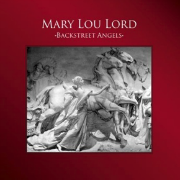
Home |
MARY LOU LORD – BACKSTREET ANGELS
(CD from Mary Lou Lord)
It’s a goddamn shame that this album had to await the crowdfunding of a Kickstarter campaign in order to exist. Terrastock alum Lord has been a favourite around Terrascope Towers since we fell in love with her first (proper) album 20 years ago. Stints on Kill Rock Stars, Sony’s flash in the pan WORK imprint, and the Terrastock-friendly but seemingly defunct Rubric Records yielded about four albums and several EPs, but Lord’s audience never seemed to expand beyond her fiercely loyal, cliquey, culty fan base. A serious vocal cord affliction sidelined her about ten years ago, nearly derailing her career. She reared a daughter, did the artist management thing, and finally got back on her feet and started an online fundraising project four years ago to produce the follow up to 2004’s warmly-received Baby Blue.
Then tragedy struck again when Lord was seriously injured and had to put the project on hold. But perseverance comes second nature to Lord (a lifetime of busking in the subway/underground demands it), and she managed to get back on her feet again to complete these 16 tracks. Early supporter Nick Saloman once again supplies a couple of exclusive tunes (and co-wrote her current single ‘My Buddy Valentine’ with collaborator Maryanne Window, an Australian singer/songwriter/manager who wrote a song for Lord a few years ago), and the album is another glorious mix of Lord originals and well-chosen reworkings of songs by Lord favourites like Lucinda Williams, Paul Westerberg, and The Green Pajamas. Lord is even helped out by legendary Fairport drummer Dave Mattacks and her daughter Annabelle, who takes over vocal duties on a few tunes as well.
The foregoing is merely a few of the reasons that this album should not have to rely on the kindness of strangers to exist. But I guess that’s more a comment on the sorry state of affairs in the music industry, where labels no longer get behind an artist unless they’re pre-selling a million units. But it’s their loss and our gain that Lord has managed to assemble the talent and friends to make this happen and share her love of music with all of us once again.
So ‘Metal Firecracker’ (courtesy Lucinda) kickstarts things off with a little country rock rattlesnake, hissing at the ears with Lord’s and David Fischer’s jingly jangly guitars in the finest Byrds-ian fashion (fans will recall Mr. Byrd, Roger McGuinn’s appearance on Lord’s Got No Shadow album supplying the guitar on Nick Saloman’s ‘Lights Are Changing’). Mattacks attacks his drum kit with his usual aplomb on the Saloman/Lord/Window co-write ‘My Buddy Valentine’, featuring another earcatching Saloman melody, gorgeous harmonies, and a gentle solo from Lord and Window, who colour in between the lines quite magnificently.
Throughout it all, Lord’s softly soothing vocals – somewhere between a sexy whisper and a Betty Boop coo – reveal her emotional attachment to the lyrics she relates as if they were her own. Saloman’s ‘D Day’ is reminiscent of his equally nostalgic folk-inflected ‘Lost Souls’ Day’ (originally on The Bevis Frond’s What Did For The Dinosaurs), with the mandolin from Mark Schwaber (Lloyd Cole, Matthew Sweet, Lou Barlow) providing just the right shade of sentimentality without becoming maudlin.
Lord’s own ‘Let’s Jet’ is an upbeat rush of fresh air amidst the more sedate tunes we’ve encountered up to now, and the country-tinged rock continues on Lord’s original ‘The Run That I’m On’, featuring a weeping lap steel “run” of his own by Mike “Slo-Mo” Brenner. The first of two Green Pajamas covers is a faithful rendering of the Big Star-ish ‘She Turns Me On’ (from the Pajamas’ 2006 rarities compilation The Night Races Into Anna), right down to Lord’s spot-on Jeff Kelly guitar solo! [Trivia time, sports fans: the song originally appeared on a Rubric Records roster sampler, Rubric 01 that also featured Lord back when she was on the label with the Pajamas, Nick Saloman, and many other Terrastock and Woronzow label veterans!]
The third Saloman-penned offering is ‘You Can Count On Me’, a tender ballad of friendship and support benefitting from another strong Saloman melody. The homestretch starts with Lord taking another run at The Green Pajamas’ ‘She’s Still Bewitching Me’, originally on the Pajamas’ Seven Fathoms Down And Falling (on Saloman’s Woronzow imprint) and previously released on Lord’s Live City Sounds recordings of tunes she busked in the Boston subway about 15 years ago. This version is more assured and obviously sounds more professional and it’s a welcome addition to her canon to hear a polished take on this long time favourite.
Annabelle gives mom a break and takes the mic on Minigell’s ‘I Feel Better’, a seemingly biographical song (in more ways than one) that Lord “hopes she somehow inspired him to write.” Like mom, like daughter, Annabelle could easily be mistaken for one of mom’s early KRS-era vocals, which augurs well for her promising future.
Benefiting from contributions from two of our finest melody makers (Saloman and Kelly), a selection of well-chosen covers, some heart-tugging originals from new kid on the songwriting block, Matt Minigell, the support and contributions from new found friends Maryanne Window, David Fischer, and producer Tony Goddess, Lord delivers one of her strongest recordings to date. That it took so long is understandable, considering its long and winding road from thought to expression. That it wasn’t made available on a grander scale by the Universals, Warners, or Sonys of the world is inexcusable. So chalk one up for crowd funding and drop Mary Lou a line to score your copy today.
(Jeff Penczak) |
| |
|
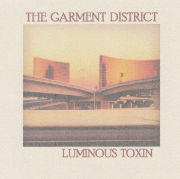
Home |
THE GARMENT DISTRICT - LUMINOUS TOXINS
(CD KS Editions )
Moving away from the dream laden tunes of last years “If You Take Your Magic Slow”, the latest release from Jennifer Baron, is a beautiful and richly atmospheric collection of instrumental tunes that have hints of Eno, Bowie and Vangelis running through them.
After the very short opening number, “The Feral Surfers” is an epic track that is truly expansive, a slow guitar creeping through clouds of musical textures, the whole thing reminding me of a movie soundtrack at the moment when the confused hero drives through the desert at twilight, unsure of his future and with a breaking heart.
Moving on, “Espy Waltz” has an unsettling feel at the beginning but this is soon resolved by the melody line, the minimalist instrumentation and arrangement sounding like Eno, the music undulating wonderfully as it moves forward. More experimental, “Echolalia” has electronic bells ringing through it, the sound manipulated and tense, whilst “Gold Vein” moves back to those icy mid seventies synth sounds, the piece drifting dreamily across the room, held down by a simple drum that comes and goes creating a tension that pulls you in.
With a delightful melody “Meeting of the Dark Sky Association” creates a whole new dynamic, a more pastoral feel emerges, music to watch clouds by although that mellow feeling will soon diminish with the arrival of “Rancho Los Feliz” a dark soundscape, that mixes drone, samples and noise into one delicious blend that ends too soon for my liking.
Ending in a more relaxed way, “”Women Who Keep the Lights” is a haunting Eastern influenced piece, the delicate melodies reminding me of “China” (Vangelis), the light and spacious production allowing the music to roam freely, hypnotising the listener with its subtle magic.
It takes a few listens to really appreciate this album’s wonders, but once it hits it becomes a wonderful collection to be savoured. (Simon Lewis) |
|
|
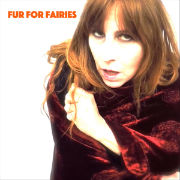
Home |
FUR FOR FAIRIES
(Green Monkey)
Well, this is weird, even by Green Monkey standards! For the uninitiated, the only clue to the music within are the credits proclaiming the whole thing was written and produced by one Jeff Kelly. Terrascopers know the name like their own – surely a new solo album from that man behind the mixing desk in the green pajamas [sic]? But who’s that sultry vixen wrapped in Chrissie Hynde’s least favourite Winter-wear? Hell, she even looks like Chrissie Hynde. Could it be…? Nah. This is Green Monkey we’re talking about here, remember! Well, the cat’s been skinned (along with, perhaps, a few rabbits, beavers, and a fox or three) and I can let you in on the secret – it’s none other than Mrs. Kelly: painter, printmaker, wife, and mom, Susanne. You may recognize her from various Green Pajamas and Kelly solo songs and album covers (both as the cover model and/or creator of the original artwork). You may even have her earlier collaboration with Jeff, last year’s By Reckless Moonlight, also on Green Monkey and reviewed by us here. Her solo turn on ‘I’d Rather Be Filming In Vanda’s Room’ convinced the loonie running Green Monkey (a certain Tom Dyer) that she deserved her shot at the big time, her very own solo album. Except her husband would write and play everything and make it sound releasable. (Mr. Dyer may be, um, adventurous and is clearly delusional, but this is a business and you don’t release nearly 80 albums over 30+ years without having some clue about what you’re doing. Well, maybe he does, but he’s an exception! I think he’s released more Green Pajamas – and related – releases than anyone else, and for that alone he’s my hero. But I digress….)
So what the heck is Fur For Fairies anyway? The Kellys may know, but they’re not talking. And Jeff’s lyrics, always an opportunity for psychoanalysis and obstreperous discussions over hidden clues that all seem to lead us into Meagan’s bed are here silent. He’s probably written more songs than he’s recorded, so perhaps there’s a ‘Fur For Fairies’ hidden away in a sock drawer somewhere to be unleashed long after the taste of his wife’s solo debut has dissipated into our subconscious memories, from which we extracted the following report:
Opener ‘My Stolen Kiss’ is a funky calypso shuffle with some menacing guitar shrieks from Jeff – imagine Marianne Faithfull’s ‘Why D’ya Do It?’ with all the naughty bits excised. Jeff still can pull off a bleeding solo with the best of them as evidenced on the hauntingly apocalyptic ‘Just Like The End Of The World’ and the weirdly autobiographical ‘If I Kissed An Angel’, wherein Susanne sings “If I kissed an angel/Would she be my wife/Lost in her forever/Would it end my life?” Surely Jeff originally intended to sing those words himself? Which raises an interesting sidebar – are these songs written specifically for Susanne, or are they refugees from the 15-volume collection of unrecorded/unreleased Jeff Kelly tunes that best suited her demeanor, voice, and sentiment? Susanne is probably the first person (after Jeff) to hear his songs as he works them out in his studio…perhaps these stuck in her head just waiting for this opportunity to unleash them? There’s an interview waiting for the Kellys right here at Terrascope Towers to answer this and other perplexing mysteries.
The romantic dreamscape of ‘Gone With The Summer’ reminds me of a slinky Nina Simone cooing in a smoky nightclub in Paris, and while ‘Toward The Dawn’ takes a little too long to see the sunlight, it does deliver another frightfully funky jam from Jeff that transported me right back to some ‘70s album from the likes of Parliament. I also liked the hesitating tease of ‘Sea of Cortez (A Bourbon Lament)’ that excitingly revisits Jeff’s Leonard Cohen fascination (perhaps shaken not stirred with a splash of Lee Hazelwood).
‘Long Way Down’ treads into bluesy territory with more Cohenesque lyrics (“I have broken all ten commandments/And I broke them ten times”) delivered in a snarly Patti Smith tongue by an equally seductive Susanne, while ‘The Singer of Another Song’ sashays around the room like Booker T speeding his MG around the Amalfi Coast. And the rear is brought up by the most Pajama-like song in the set, the lilting waltz ‘The Lost Weekend (Autumn 1992)’. Could this date back to the Portugal period?
Ultimately, the album may be judged as just another Jeff Kelly side project, which would be a tragic misappropriation of the credit due Susanne for bravely tackling another art form. Green Monkey have eased her into the music profession by placing her behind a pseudonym, and while there is no escaping Jeff’s musical imprint, props to the Mrs. for an engaging, courageous work that, despite a few warts, left a satisfactory impression on these ears.
(Jeff Penczak) |
| |
|

Home |
IN GOWAN RING - THE SERPENT AND THE DOVE
LP / CD from In Gowan Ring
This is a lovely record, filled with glorious melodic twists and turns and surprising little dives down into the byways of spiritual folk and magical traditions. While I’m sure many hours went into lovingly sequencing the album, I’d actually recommend playing Side 2 first, as you immediately get the full effect of B’ee’s enchanting, resonant voice as it powers its way through one of the strongest songs on the whole LP, the side’s opener ‘Set a Candle in the Night’, and closes with a haunting instrumental (strings, mainly, although you never quite know given In Gowan Ring’s penchant for using home-made instrumentation, listing pear guitar, harp, psaltery, string drones, Nyckelharpa, hurdy-gurdy and flute amongst their armoury) entitled ‘The Dove’. That may be one of the shortest tracks on here, but it’s also one of the most beautiful.
Flip the record over to what mere mortals, who haven’t the beneft of reading this review, would refer to as Side A and the lilting chimes that close ‘The Dove’ are picked up and echoed in the opening ‘The Serpent’. I could quite honestly listen to a full hour of this musical spirit landscape with curious echoes of both the Balkans and the middle-east, and still consider myself short-changed. Luckily for everyone else however B'ee saw fit to quickly move along to the next song in the sequence.
‘Thousands of Bees’ is in may ways the c entrepiece of the album, B’ee’s lovely voice as it intones soft, psychedelic whimsy (“the plants shone a strange light from their leaves / I drew closer to the coloured shapes, illuminating the folds of my cape / and my sleeves…”) sailing a delicate counterpoint to the lead viola. I love this song. I love how it dies, falters, stumbles, and dies again before the gentle medieaval strains of the utterly gorgeous poem set to music (and what music!) ‘Sial at Play’ picks it up and dances away with it. And then to close there’s a quite simply entrancing love song to a favourite tree, ‘Julia Willow’ (“wrapping arms within the voice of the winds / her gown starying in moonlight and dew”). Brilliant. Psychedelic folk album of the year for me, no question. entrepiece of the album, B’ee’s lovely voice as it intones soft, psychedelic whimsy (“the plants shone a strange light from their leaves / I drew closer to the coloured shapes, illuminating the folds of my cape / and my sleeves…”) sailing a delicate counterpoint to the lead viola. I love this song. I love how it dies, falters, stumbles, and dies again before the gentle medieaval strains of the utterly gorgeous poem set to music (and what music!) ‘Sial at Play’ picks it up and dances away with it. And then to close there’s a quite simply entrancing love song to a favourite tree, ‘Julia Willow’ (“wrapping arms within the voice of the winds / her gown starying in moonlight and dew”). Brilliant. Psychedelic folk album of the year for me, no question.
Oh, and there's also a 45 available which features 'Sial at Play' on one side and the full version, with vocals, of 'The Serpent and The Dove' on the other. Needless to say, you need that too
(Phil McMullen) |
|
|
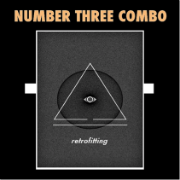
Home |
NUMBER THREE COMBO – RETROFITTING
CD on SlowBurn Records
Prolific guitarist Eric Johnson has released a number of recordings since the demise of Black Sun Ensemble following Jesus Acedo’s death in 2013. As a member of Bread and Circus, Cobracalia, and Sundarata, he’s contributed to several albums (all on his SlowBurn imprint) of mellow, eastern-flavoured Ensemble-like music. His latest project is a trio he formed with ex-Black Sun Ensemble flautist Joe E. Furno and his Cobracalia partner, Middle Eastern master percussionist Carl Hall (featured here on dumbek).
As with the previous projects, there is a contemplative, eastern vibe wafting across these recordings, but Johnson and company have upped the mellow quotient by focusing on Johnson’s 12-string acoustic, the occasional table drum loop, and Furno’s electronically-treated flute. Opener ‘The Empty Quarter’ sets the stage, with relaxing melodies and a Middle Eastern vibe.
Johnson’s vocals and Furno’s flittering flute create the perfect ruminating feeling for the 70-year old daydreaming blues standard, ‘Driftin’ Blues’, while chiming acoustic guitars, laid-back percussion and soaring flute combine to lift the organic ‘Sonora’ into a shimmering dance amongst cumulous clouds floating across lazy blue skies.
There’s a bizarre bazaar vibe chunnelling through ‘Citadel’ (not the Stones song) that wouldn’t be misplaced on the Stones’ track’s parent album. Another laidback navelgazer, the Black Sun pedigree is apparent, but the trio have reined in the excessive desert wanderings that occasionally dogged Acedo & Co.’s trippier artifacts. ‘Last River’ sounds like it was written as an oasis after a long, aimless stroll through the desert; it’s cool, melodic waters wash refreshingly over long day’s journeyers venturing into unchartered destinations.
Relaxing…contemplative…pastoral…. These are feelings that are all-too-often missing from today’s loud and aggressive rock tunes. Thanks to Johnson and his cohorts, Number Three Combo restore peace and quiet to a breakneck-paced world, turning daydream believers into all who venture under their spell.
(Jeff Penczak) |
| |
|
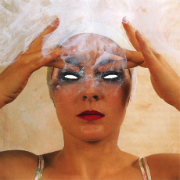
Home |
HEY COLOSSUS – RADIO STATIC HIGH
(VINYL LP/CD/Download from Rocket Recordings http://rocketrecordings.blogspot.co.uk/)
It’s a mark of a great band that they can continually reinvent their sound without breaking stride and still nail it. Hey Colossus are one of those slightly mysterious acts who uncompromisingly plough their own cussed furrow (interesting how so many of these bands tend to gravitate towards Rocket Recordings). They also give the impression of being able to hit the bullseye time and again even when seemingly throwing blindfolded using their feet.
Whereas 2011’s RRR, for example, was one gloriously scary, serrated swathe of noise, this year’s Black and Gold wrong footed a few commentators who expected more of the same but were met with something slightly more throttled back and which might be considered the band’s “crossover” although quite with what I’m not sure. Fast forward just a few months and the band has released its second long player of the year. Radio Static High represents a further incremental shift from the teeth-grinding noiserock of yore which on first appearances might lead one to think that they have gone soft. Except that first appearances, as we know, can lie through their arse and that while the album has a more indie and varied feel to it, what is evident here is a different kind of energy and one which on the evidence of recent live performances complements the band’s howling and more visceral racket.
No, this album lacks nothing in the way of guts and it simply oozes quality. The Earth-like “Memories of Wonder” exerts one dense gravitational pull and the aptly named “March of the Headaches” and “Hesitation Time” are reminiscent of Billy Corgan’s prime era Smashing Pumpkins at their snarkiest. “Numbed Out” is a distillation of all that was good with that “release the bats” Goth scene of the 1980s while “The Mourning Gong” evokes early Sleepy Suns or Dead Meadows’ more laconic moments, a lazy, meandering and shimmering sliver of psych. Best though is the atypically angular, no wave motorik of “Hop The Railings”. When Rocket’s Chris Reeder DJ’d this at Psych fest the other weekend some very well informed company was floored when informed who it was by. Were they impressed? You betcha.
Like stable mates Gnod, audiences and critics have to either grow or change with Hey Colossus or else hop off a speeding train. Get with it and enjoy the ride. Better still stick it on your Christmas list.
Hey, colossal.
(Ian Fraser) |
|
|
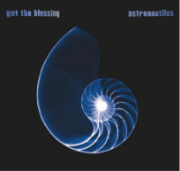
Home |
GET THE BLESSING – ASTRONAUTILUS
(Vinyl LP/CD from Naim Records
http://www.naimlabel.com/
They’ve released five albums all told, are from Bristol and their sound is comprised of a trumpet, a saxophone, drums and bass guitar – pretty much your classic Blue Note four-nil-nil formation - the drummer and bassist in question being Clive Deamer and Jim Barr the rhythm section for Portishead. The latter also produces Terrascope favourites and quasi-house band Thought Forms so, all told, they boast a pretty impressive pedigree on paper. It turns out they’re pretty hot on wax, too.
Now some of this takes me back to the late 90s when for some reason I was listening to a lot of jazz-inclined “dance” music – Lamb, Red Snapper and the like. Acid jazz beats and jazz skronk that not only exhibits a great appreciation of Ornette Coleman and Coltrane but also provide a modern take on some of Gong’s more avant-garde, “knockabout” moments from around the time of Camembert (“Monkfish” – Thelonius of course - and the goofy, alternately melodic and propulsive “Green Herring”) and the more enjoyable moments of post-Wyatt Soft Machine (“Nautilus”, “Hayk”).
It’s a neat bundle in which lively kickers like “Phaenamena” nestle comfortably with the cerebral insularity of “Carapace”, “Conch”, the dub-drone of “Sepia” and the oddball, skewwhiff urgency of “Cornish Native”. All told, music to get lost in while at the same time raising a smile and a smile, as an old band from many moons ago once sang, is diamond.
(Ian Fraser) |
| |
|
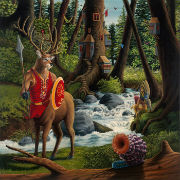
Home |
CLASS M PLANETS – DEERPATH
(LP/CD/DL http://totallytotallypunk.blogspot.co.uk/)
Using a variety of musicians, Adam Goldman has created a wonderful collection of gently flowing songs that have a lo-fi heart yet sound alive and timeless thanks to their arrangements and sympathetic production values.
Catching the ear, “Kind Of” opens the record with a wistful guitar and soft vocals, reminding me of In Gowan Ring playing the songs of Bright Eyes, a drifting piano adding an extra dimension to the song. Equally lovely, “True Compass” has lyrics that spin pictures in your brain, the sweet tune giving the words a magical cloak on which to fly, whilst “Timepiece” has a rockier feel, thanks to the up front drums, although the gentleness remains just below the surface.
Throughout side one there is a beautiful flow to the album each track perfectly situated on the disc with the magnificent folk sweetness of “Riverbound” being the absolute highlight, sounding like The Incredible String Band circa 1968. To end the side, “Gravity” leads you out into a dappled woodland glade for a bit of a jig and a refreshing glass of ale before side two.
Ensuring the quality continues, “Umbrella” has a slightly jazzy feel and interesting synth lines running through it, whilst “Broken English” is slow and nostalgic with lovely vocals from Kaitlyn Ni Donovan that add variation to proceedings.
As the collection plays, your ear catches melodies, fragments of lyrics stick in your head and you find yourself humming along and tapping your feet with a smile on your face until, eventually, the album ends with the title track itself, an energetic strum of a song that offers hope and encouragement in this strange world of ours.
Working with artist Cary Porter, the album is housed in a magical gatefold sleeve that is illustrated with fantasy creatures, all involved in a quest, giving the cover a narrative feel that fits perfectly with the musical contents and giving you plenty to look at whilst it plays. Something of a slow burner this album is a pastoral triumph, a delightful collection of tunes that is perfect for a chilled evening around the fire. (Simon Lewis) |
| |
|
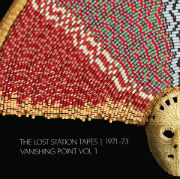
Home |
THE LOST STATION TAPES 1971-73 VANISHING POINT VOL 1
(2xLP http://www.futurewizards.com/)
So here's a strange one, a double heavyweight vinyl release that showcases four sides of extended jamming played by three unknown musicians way back in the early seventies, discovered in a small studio and brought back to life by Future Wizard / Zap records. Worthy of note is the excellent packaging with artwork by artists Fantich and Young as well as the excellent pressing and sound quality of the release.
So far so good, but what does it actually sound like ? Well, fans of Robin Trower or Jeff Beck are gonna find plenty to love on this album as it is filled with classic rock jamming with a funky edge and a really tight rhythm section, something that allows the guitarist to wander wherever he wants, and he does, his style fluid and melodic with plenty of changes in pace and texture. Over four sides there is plenty to admire, all four maintaining the quality making for a very pleasurable journey and it is certainly possible to listen to all four sides without getting bored.
Limited to 100 copies this is bound to sell out quickly so fans of extended guitar histrionics and fancy fretwork should get in quick as this is a quality collection that has echoes of guitarists such as Hendrix or Saloman running through it. (Simon Lewis) |
| |
|
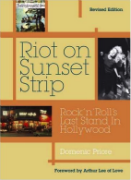
Home |
DOMENIC PRIORE – RIOT ON SUNSET STRIP
(Book published by Jawbone Press)
Subtitled “Rock ‘n’ Roll’s Last Stand in Hollywood”, Priore’s tome is an exhaustive study of the bands, clothes, TV shows, movies, and songs that resonated from a seemingly endless collection of teen dance clubs centred around Hollywood’s Sunset Boulevard ca. 1964-66. Artificially bookending his study between The Byrds’ debut at Ciro’s on March 26, 1965 and the notorious November 12, 1966 riots/demonstrations that give the book its title, he traces the history of “the Strip” from its early heyday as a hangout for movie stars and the idle rich in the ’20’s through the mass exodus to Las Vegas in the ’40s. Soon, new clubs began sprouting up featuring jazz and r&b entertainers from Louis Prima, Billy Eckstein and Charles Mingus to Charlie Parker, Dizzy Gillespie, Chet Baker, Louis Armstrong, and Duke Ellington. Comedy clubs such as The Interlude featured Woody Allen, Lenny Bruce, and Lord Buckley, and soon new clubs were presenting sets from the new folk scene via The Everly Brothers, the Modern Folk Quartet, The Byrds, Turtles, Buffalo Springfield, et. al. Priore devotes whole chapters to the burgeoning rockabilly scene and finally introduces the garage rock and surf scene that dominated local clubs throughout the mid-60s.
While Priore’s research is commendable, sometimes it feels as if he’s imparting TOO MUCH information, as we read pages and pages of real estate transfers involving the closing, opening, closing, reopening, and renaming of nightclub after nightclub all along the Strip and its famous neighbouring hangouts along Hollywood Boulevard, Santa Monica Boulevard, Melrose Avenue, and La Cieniga Boulevard. A nearly 20-page appendix of “The Scene” lists just about every boutique, restaurant, book store, record store, nightclub, hotel, drug store, record label and recording studio that sprang up during the period. While interesting to trace the development of the changing tastes and popularity of the different offerings available to the teenagers of the day, it soon becomes just a long list of forgotten names and addresses that soon lose their impact and interest. Yes, who played in Los Angeles during this period, who was popular, and how they made and/or influenced later rock and roll history is interesting. Where they played…not so much. Unless you lived there at the time, this long list of club names doesn’t have any value.
The book does shine when Priore explains the impact and camaraderie of the various little neighbourhoods adjoining the Strip itself, giving us a thorough overview of the r&b, Chicano, and soul sounds from East L.A. that eventually yielded Billy Preston, Thee Midnighters, The Rivingtons, the pre-Redbone work of Pat & Lolly Vegas, Ritchie Valens, Cannibal and The Headhunters, and War. Extensive coverage is afforded the numerous garage bands that sprang from the area – so much so, that you could probable assemble your own L.A. Nuggets box set and never duplicate anything in the Rhino collection! However, one of the problems with the endless litany of garage rockers is that many were one hit (or no hit) wonders who only shone brightly for a few weeks in the Strip scene and were never heard from again. So without an accompanying CD to showcase any of these artists, the effect is minimised. It’s also frustrating that most of these artists are excluded from his Index, so if you recall reading about a certain act or song, you have to thumb through the entire book to find the reference. And while there’s also a wonderful chapter devoted to the omnipresent “surfink” hot rod, T-shirt, and collage art that graced the scene, without a sampling of the art in his photo sections, the effect is lost.
Priore relates stories about every major musical style that passed through L.A., with sections discussing the surf scene (The Belairs, Dick Dale, The Surfaris, and The Chantays), folk (Judy Henske, Bob Lind, Hoyt Axton, Barry McGuire, The Righteous Brothers, Tim Buckley), lengthy recaps of The Byrds, Love, The Turtles, The Doors, The Grass Roots, The Dillards, The Stone Poneys, et.al. The Misunderstood, Merrill Frankhauser, Captain Beefheart, and Zappa and The Mothers also flit and flutter throughout, as do The Rising Sons, The Leaves, Jackie DeShannon, The Chocolate Watchband, The Standells, Lee Hazelwood, Strawberry Alarm Clock, Three Dog Night, the Bobby Fuller Four, and of course The Beach Boys – a veritable rock and roll hall of fame all seem to have started or honed their careers at the dozens of clubs along “the Strip”.
On the disappointing side, Priore’s Bibliography is pretty flimsy, failing even to include some of his publisher’s own books on artists like Love, The Byrds, Lee Hazelwood, and P.F. Sloan. Ritchie Unterberger’s definitive 2-volume overview of Folk Rock is also conspicuous in its absence, as are Kent Crowley and Jon Blair’s definitive histories of surf music.
Also inexcusable are the innumerable typos and factual errors that this so-called “Revised Edition” should have caught and corrected (e.g., the Chip Douglas character on My Three Sons TV show was not the producer/songwriter brother of actor Jon Voight as one Index reference indicates; Jackie Cooper – not Coogan, aka The Addams Family’s Uncle Fester, co-starred with Chaplin in The Kid; Phil Spector produced Let It Be, not The Beatles (aka “White Album”); suggestions that The Seeds coined the term “flower power” (as reported by keyboardist Daryl Hooper) are not corrected, and claiming that The Electric Prunes’ ‘Are You Loving Me More’ from their 1967 debut “recalls The Pink Floyd’s ‘Lucifer Sam’” is impossible since the Prunes’ debut was released four months BEFORE the Floyd’s debut; and does anyone really still think that Love’s ‘Signed, D.C.’ is about drummer Don Conka’s heroin addiction? Even songwriter Arthur Lee has denied this. There are just too many of these lazy errors that make one wonder what, if anything really was “revised” from the original 2007 publication.
But despite these annoying oversights, there is much to applaud here. His overview of all the TV shows and movies that piggybacked onto the area’s rock scene by featuring local bands in various episodes is a treasure trove of useful information for You Tube surfers; his discussion of the key producers during this era (Curt Boettcher, Phil Spector, Lee Hazelwood, Sonny Bono, and Dave Hassinger) is informative, as is his praise for key disc jockeys who helped get the music on the air. I wish he could have expanded his Index or added another Appendix with a consolidated Discography of all the records he mentions throughout the book – trainspotters and dumpster divers would have a field day tracking these rarities down.
Priore ends by updating the current status of the Strip…and it’s not a pretty picture. The elitist, pay-to-play booking policy at the Whisky a Go Go and Troubadour killed all their interesting bills, leading to many bands bypassing L.A. altogether. Other clubs turned into strip joints or closed down completely or tried to revive the fading scene by catering to movie industry insiders (e.g., Johnny Depp’s Viper Room, Le Dome, Spago, The Standard.) Some are empty storefronts or parking lots. And despite Priore’s claim that it was the “election of right wing extremist Ronald Reagan as Governor” along with conservative types on the city council that caused the titular “riot on Sunset Strip” and killed the scene by enforcing (or passing) ludicrous curfew laws, he seems to have overlooked the fact that the arrival of drugs like cocaine, PCP, and heroin, along with general boredom and the transfer of much of the media focus and quality bands to San Francisco and the ensuing hippie/psychedelic scene could be as equally guilty. And don’t even get me started on Priore’s liberal political agenda trickling into his text when he discusses the demise of the Strip’s heyday, or his obvious disdain for anything emanating from San Francisco!
Still, for a nostalgic peek back at a critical period in rock and roll, few books are as comprehensive. Just be sure to take his pronouncements and effulvent hyperbole with a grain of salt, particularly if you’re from San Francisco or of a conservative bent!
(Jeff Penczak) |
| |
|
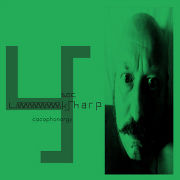
Home |
DOC LUDEN LOOKSHARP – CACOPHONORGY
LP/DL Furry Heart Records
Inspired by Italian Futurist Luigi Russolo and his self constructed noise generators known as intonarumori, Doc Looksharp decided to create his own device using an old Singer sewing machine and a host of household objects such as springs and rubber bands, the resultants sounds then fed through loopers, echoes etc (Something Russolo never enjoyed as he died in 1947) to create pieces of Avante Garde noise that mix Musique Concrete, Industrial sounds, and surreal playfulness with the more difficult moments in Kraut and Psych.
Opening with the sinister pulse of “Te Ves Hermosa Cagando” (depending whether the tracklist on the label or sleeve is correct) the music could be the background for a strange film-noire, the pulse coated in strangeness and unexpected sounds. On “Go Back In Time, Kill Your Parents” things seemed to be moving in slow motion, rumbles, creaks and a distorted rhythm sounding like the Aphex Twin on Ketamine, a mangled vocal line adding a disturbing atmosphere to the piece, the title of the track repeated over and over. Even harsher, the sounds at the beginning of “Long Eroin Nynpho” are the equivalents of robotic nails across a virtual blackboard, the uneasy listening augmented by a deep vocal offering to fuck you, the lyrics cut up and hardly romantic, the whole piece charged with tension reminding me of Throbbing Gristle, only the beat making sense to your ears.
Over on side two the fun continues with the playfully titled “I See Living Creatures” another dense track that seems to encompass the entire history of experimental music within its grooves, crackles and beats fighting it out until the beats become victorious, the track becoming almost a song, heavily treated vocals merging with the rhythms reminding me of the Beastie Boys playing “Intergalactic” at an industrial convention.
Warmer in tone “Motormouth” is full of chimes and melody, with some (almost) throat singing added in and a guitar, quite possibly not a guitar, creating simple solos and textures, the whole album finished off by “At The Mountains of Madness” a dark cloud of drone that sweeps across the landscape coating everything in a thick layer of noise and then driving the point home with a throbbing bassline that sounds like Hawkwind buried deep within the desert and unsure of the way out, the track finally collapsing in on itself as the energy dissipates and scatters to the four winds, only to return briefly before burning out.
Whilst there is definitely a harsh and difficult undercurrent to this album there is also plenty of warmth and humour, the resultant mix a highly entertaining collection that bears repeated listening, all hail the cacophonator. (Simon Lewis) |
| |
|
|
 |
|

